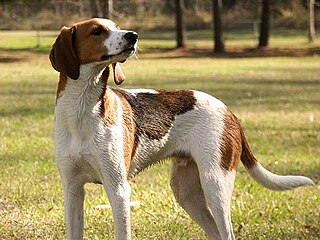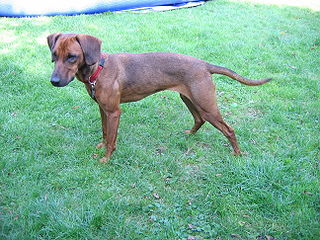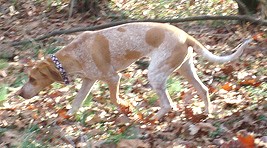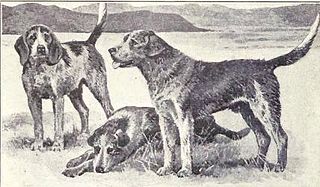
The beagle is a breed of small scent hound, similar in appearance to the much larger foxhound. The beagle was developed primarily for hunting hare, known as beagling. Possessing a great sense of smell and superior tracking instincts, the beagle is the primary breed used as a detection dog for prohibited agricultural imports and foodstuffs in quarantine around the world. The beagle is intelligent and is a popular pet due to its size, good temper, and a lack of inherited health problems.

The Harrier is a medium-sized dog breed of the hound class, used for hunting hares by trailing them. It resembles an English Foxhound but is slightly smaller, though not as small as a Beagle. The breed has been used since the mid 13th century.

The Basset Hound is a short-legged breed of dog in the hound family. The Basset is a scent hound that was originally bred for the purpose of hunting hare. Their sense of smell and ability to ground-scent is second only to the Bloodhound.

Scent hounds are a type of hound that primarily hunts by scent rather than sight. These breeds are hunting dogs and are generally regarded as having some of the most sensitive noses among dogs. Scent hounds specialize in following scent or smells. Most of them tend to have long, drooping ears and large nasal cavities to enhance smell sensitivity. They relatively need to have high endurance to be able to keep track of scent over long distances and rough terrain. It is believed that they were originally bred by the Celts.

The American Foxhound is a breed of dog that is a cousin of the English Foxhound. They are scent hounds, bred to hunt foxes by scent.

The Artois Hound is a rare breed of dog, and a descendant of the Bloodhound. A scent hound 22–23 inches high at the withers, weighing anything between 55 and 65 pounds, it is a well constructed dog with a slow graceful gait. It has a large, strong head, a medium-length back and a pointed tail that tends to be long and sickle-shaped. Their ears are set at eye level; they have large prominent eyes and quite thick lips.

The Treeing Walker Coonhound is a breed of hound descended from the English and American Foxhounds. The breed originated in the United States when a stolen dog known as "Tennessee Lead" was crossed into the Walker Hound in the 19th century. The Treeing Walker Coonhound was recognized officially as a breed by the United Kennel Club in 1945 and by the American Kennel Club in 2012.

The Polish Hound, commonly known as Ogar Polski, is a breed of hunting dog indigenous to Poland. The Polish Hound has a keen sense of smell. This heightened sense combined with the endurance needed to hunt in harsh environments led to its use in hunting, while its stature made it popular with Polish nobility.

The Tyrolean Hound is a breed of dog that originated in Tyrol also called the Tiroler Bracke or Tyroler Bracke. They are scent hounds that descended from the Celtic hounds in the late 1800s, mainly for their hunting skills. They are hardworking, passionate, and independent dogs not known for their size, but rather their intelligence. For that reason, hunters can regularly use these dogs to catch their prey, wounded or otherwise. Their ability to stretch over long distances, on rough hot or cold terrain for their prey is also another perk of keeping this dog by your side. Hunters do have to worry about injuries to their dog, however, along with the common injuries that these dogs obtain throughout their life, like hip dysplasia or ear infections. Barring any injuries, these dogs tend to live an energetic life for about 12-14 years, and tend to be an overall healthy and robust dog.

The Gascon Saintongeois is a breed of dog of the scenthound type, recognised in two varieties, Grand (large) and Petit. Originating in France, the breed is used for hunting in packs and descends from the old Hound of Saintonge type of large hunting dog.

The Drever is a breed of dog, a short-legged scenthound from Sweden used for hunting deer and other game. The Drever is descended from the Westphalian Dachsbracke, a type of German hound called Bracke. The breed name Drever was chosen through a contest in 1947.

The Porcelaine[pɔʁsəlɛn] is a breed of dog originating from France. In 1844, this scent hound was originally called “Briquets Francs Comtois” and named after a French region bordering Switzerland.

The Transylvanian Hound is a dog breed originating from Hungary and Transylvania and was historically primarily used for hunting. It is a strong, medium-sized scent hound, characterized by a black body, with tan and sometimes white markings on the muzzle, chest and extremities, and distinctive tan eyebrow spots. It has a high-pitched bark for a dog of its size. The breed was rescued from extinction by focused breeding efforts in the late 20th century. There were formerly two varieties, the tall and the short, developed for different kinds of hunting in the Middle Ages. Only the tall variety survives today.

The English Coonhound, also referred to as the American English Coonhound or the Redtick Coonhound, is a breed of coonhound that originated in and is typically bred in the Southern United States. It is descended from hunting hounds, especially foxhounds, brought to America by settlers during the 17th and 18th centuries. The breed's first recognition came from the United Kennel Club in 1905 as the English Fox and Coonhound. Further recognition has been granted in recent years by the American Kennel Club, first in the Foundation Stock Service and in 2011 as a fully recognized member of the hound group.

The Welsh Hound is a breed of hunting dog of the foxhound type, indigenous to Wales.

The Basset Artésien Normand is a short legged hound type dog developed in France. The word basset refers to short-legged hounds.

The Halden Hound, is a medium-sized Norwegian dog breed of the hound class, used for hunting hares and other plains quarry. It resembles an American Foxhound but is smaller. It was named after Halden, a town in southeastern Norway.

The Petit Bleu de Gascogne is a breed of dog of the scenthound type, originating in France and used for hunting in packs. Today's breed is the descendant of a large hunting dog. The Petit Bleu de Gascogne is not a small (petite) dog, the name comes from its use on small game.

The Schweizerischer Niederlaufhund, is a breed of dog of the scenthound type from Switzerland. Niederlaufhund means short-legged hound. The breed has a number of different varieties.

The American Staghound, referred to by various names including the Cold-Blooded Greyhound, the Longdog of the Prairie and the American Lurcher, is a crossbreed of various sighthounds. It has been bred in the United States from the 19th century where it is used for hunting.




















